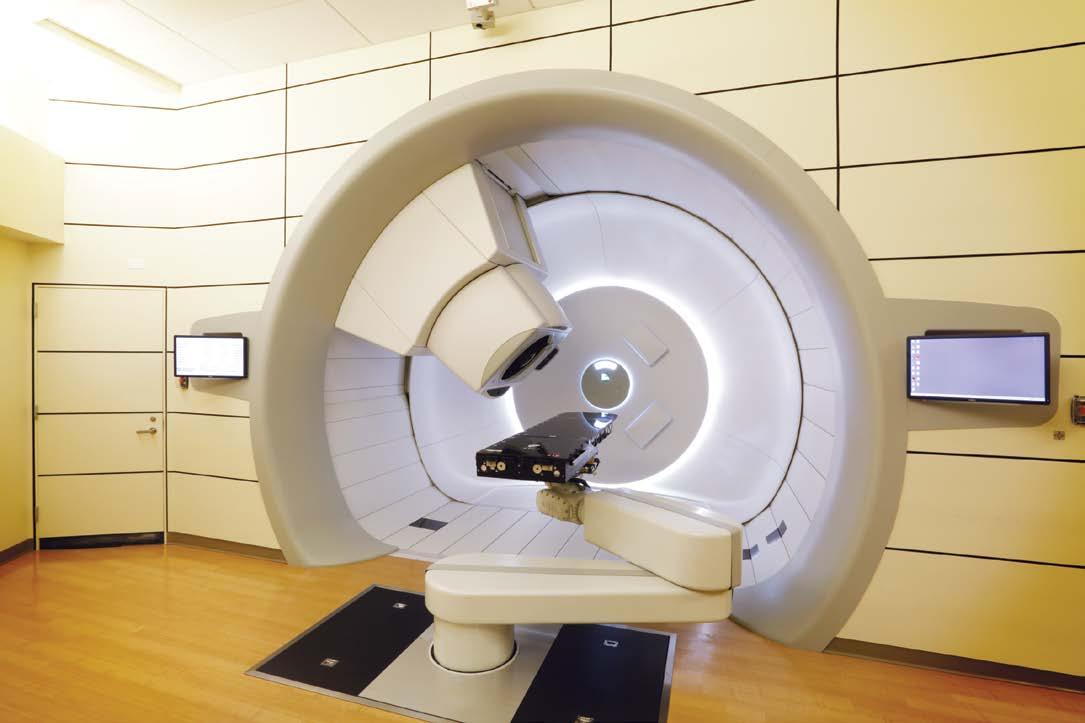
3 minute read
What is proton therapy?
Proton therapy is a type of radiation therapy that uses beams of protons (tiny particles with a positive charge) to kill tumor cells . This type of treatment can reduce the amount of radiation damage to healthy tissue near a tumor . It is used to treat cancers of the head and neck and organs such as the brain, eye, lung, spine, and prostate . Proton beam radiation is different from standard X-ray radiation .
Research shows proton therapy can minimize short- and long-term side effects, reduce the occurrence of secondary tumors and improve patients’ quality of life .
Advertisement
Because it can be so precisely targeted, proton radiation is especially useful for childhood cancers, where the impact of excess radiation can cause long-term damage .
How does proton therapy differ from standard X-ray radiation?
The biggest difference between proton therapy and standard radiation is that standard radiation uses X-rays to deliver radiation to the tumor and beyond it . This can cause damage to nearby healthy tissues .
Proton radiation delivers a beam of protons that stops at the tumor . This reduces the amount of radiation to healthy tissue near the tumor .
See the images below for detail .
Sinuses
Eyes Standard radiation Proton radiation therapy
Sinuses
Eyes
Tumor
Less Radiation Radiation levels
More Radiation Tumor
What can I expect with proton therapy?
Proton therapy is safe, noninvasive and painless for most patients . It does not require an overnight stay in the hospital . Treatments are usually given five days a week, for a period of one to nine weeks . The total number of treatments needed depends on the location and size of the tumor . Daily treatment sessions may last up to 30 minutes . Most of that time is spent making sure you’re in the right position for treatment . The radiation therapy typically lasts just a few minutes .
Studies have shown proton therapy can help treat a broad range of tumors, including those of the brain, central nervous system, gastrointestinal tract, head and neck, left breast, lung and prostate, as well as sarcomas (tumors in the bones and soft tissues) .
Depth dose curves for protons and photons (standard radiation)
300
Relative doses (%) 250
200
150
100
50 10 MeV photons Photons
Protons
Additional dose outside the target delivered with photons
Proton “Spread Out Bragg Peak”
Tumor
0
0 50 100 150 200 250 300 350 400 Depth in water (mm)
A closer look at the science behind proton therapy
Protons are heavy charged particles that can be manipulated to release their energy at a precise point . The more energy, the deeper the protons can penetrate into the body . The amount of proton energy is calculated to release the proton radiation precisely at the tumor site . The peak of this radiation dose (called the Bragg Peak, named after William Henry Bragg, who discovered it in 1903) is designed to conform to the shape of the tumor . Immediately after that point, the radiation dose falls to zero .
You can find information on disease-specific conditions and proton therapy, as well as many disease-specific resources, at seattlecca.org/treatments/proton-therapy.
Insurance coverage
Many U .S . insurance providers, including Medicare and many state Medicaid programs, cover proton therapy treatments .
Before your first consultation, we will confirm your benefits and coverage . We will also find out if your insurance provider requires authorization for treatment . If it does, we will request it after your doctor confirms you are a candidate for proton therapy . Please note that authorization can take up to two weeks .
After your insurance carrier makes a decision, your patient care coordinator will contact you to discuss next steps . You can check in with your patient care coordinator to find out the status of the request at any time; however, we will contact you once we have received the decision .
Your patient care coordinator, who is also a financial counselor, will help you understand your insurance benefits and provide you an estimate of your cost responsibility before your first treatment .




